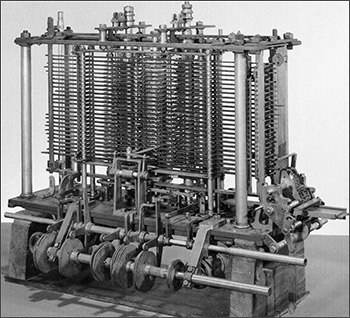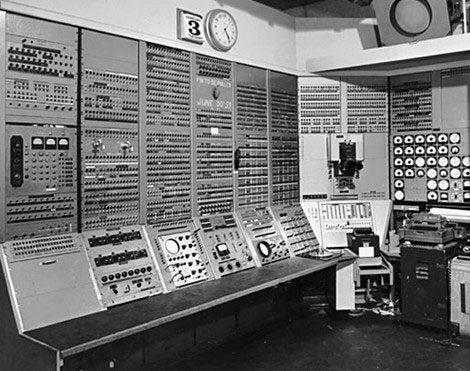History of computer
History of computer
Charles Babbage :-
Charles Babbage was considered to be the father of computing after his invention and concept of the Analytical Engine in 1837. The Analytical Engine contained an Arithmetic Logic Unit (ALU), basic flow control, and integrated memory; hailed as the first general-purpose computer concept. in 1910 Henry Babbage, Charles Babbage's youngest son was able to complete a portion of the machine that could perform basic calculations.![]()
Charles Babbage was considered to be the father of computing after his invention and concept of the Analytical Engine in 1837. The Analytical Engine contained an Arithmetic Logic Unit (ALU), basic flow control, and integrated memory; hailed as the first general-purpose computer concept. in 1910 Henry Babbage, Charles Babbage's youngest son was able to complete a portion of the machine that could perform basic calculations.
Father of the computer :-
There are several people who can be considered the father of the computer including Alan Turing, John Atanasoff, and John von Neumann. However, for the purpose of this document we're going to be considering Konrad Zuse as the father of the computer with his development of the Z1, Z2, Z3, and Z4.
In 1936 to 1938 Konrad Zuse created the Z1 in his parent's living room. The Z1 consisted of over 30,000 metal parts and is considered to be the first electro-mechanical binary programmable computer. In 1939, the German military commissioned Zuse to build the Z2, which was largely based on the Z1. Later, he completed the Z3 in May of 1941, the Z3 was a revolutionary computer for its time and is considered the first electromechanical and program-controlled computer. Finally, on July 12, 1950, Zuse completed and shipped the Z4 computer, which is considered to be the first commercial computer.
![]()
Father of the personal computer :-
Ed RobertsHenry Edward Roberts coined the term "personal computer" and is considered to be the father of the modern personal computers after he released of the Altair 8800 on December 19, 1974. It was later published on the front cover of Popular Electronics in 1975 making it an overnight success.
By August 1975, over 5,000 Altair 8800 personal computers were sold; starting the personal computer revolution.
![]()
The first digital computers were developed between 1940 to 1945.
Konrad Zuse, In 1941 developed “Z3”, the first modern computing machine.
Konrad Zuse is regarded as “the inventor of computers”.
ENIAC (Electronic Numerical Integrator & Computer) was the first US-built electronic computer.
ENIAC was developed by John Mauchly and J. Presper Eckert.
The world’s first stored-program computer was “Manchester Baby” developed in 1948.
The “Manchester Baby” was a small-scale experimental computer developed in Victoria university of Manchester.
In the 1st generation of computers, Computers were built with vacuum tubes.
In 1957, FORTRAN (Formula Translator) was introduced.
Computers were built with Transistors in the 2nd generation of computers.
In the 3rd generation of computers, Transistors were replaced with Integrated Circuits.
In the 4th generation of computers, Microprocessors were used to built Computers.
In 1981, IBM PC with Intel processors and MS-Dos were introduced.
In 1984, Macintosh Computers were introduced.
In 1985, Microsoft Windows GUI was introduced.
In 1989, Intel 486 computers were introduced.
In 1990, Windows 3.0 operating System for PCs was launched.
In 1991, the World Wide Web was introduced to the general public.
In 1991, Linux operating was developed.
In 1993, Intel’s Pentium was introduced.
In 1995, windows 95 operating system was made released.
In June, 1996 Windows 4.0 operating system was released.
On February 17, 2000, Windows 2000 was released.
Windows XP was released on 25th October, 2001.
On November 30th, 2006 Windows Vista was released.
On July 22nd 2009, Windows 7 was introduced.
On Windows 8, the successor of Windows 7 was released on October 28th, 2012.
Konrad Zuse, In 1941 developed “Z3”, the first modern computing machine.
Konrad Zuse is regarded as “the inventor of computers”.
ENIAC (Electronic Numerical Integrator & Computer) was the first US-built electronic computer.
ENIAC was developed by John Mauchly and J. Presper Eckert.
The world’s first stored-program computer was “Manchester Baby” developed in 1948.
The “Manchester Baby” was a small-scale experimental computer developed in Victoria university of Manchester.
In the 1st generation of computers, Computers were built with vacuum tubes.
In 1957, FORTRAN (Formula Translator) was introduced.
Computers were built with Transistors in the 2nd generation of computers.
In the 3rd generation of computers, Transistors were replaced with Integrated Circuits.
In the 4th generation of computers, Microprocessors were used to built Computers.
In 1981, IBM PC with Intel processors and MS-Dos were introduced.
In 1984, Macintosh Computers were introduced.
In 1985, Microsoft Windows GUI was introduced.
In 1989, Intel 486 computers were introduced.
In 1990, Windows 3.0 operating System for PCs was launched.
In 1991, the World Wide Web was introduced to the general public.
In 1991, Linux operating was developed.
In 1993, Intel’s Pentium was introduced.
In 1995, windows 95 operating system was made released.
In June, 1996 Windows 4.0 operating system was released.
On February 17, 2000, Windows 2000 was released.
Windows XP was released on 25th October, 2001.
On November 30th, 2006 Windows Vista was released.
On July 22nd 2009, Windows 7 was introduced.
On Windows 8, the successor of Windows 7 was released on October 28th, 2012.
First general-purpose computer
In 1837, Charles Babbage proposed the first general mechanical computer, the Analytical Engine. The Analytical Engine contained an ALU (arithmetic logic unit), basic flow control, punch cards and integrated memory. It is the first general-purpose computer concept that could be used for many things, not only one particular computation. Unfortunately, because of funding issues, this computer was never built while Charles Babbage was alive. In 1910, Henry Babbage, Charles Babbage's youngest son, completed a portion of this machine and performed basic calculations.


The first machine to record and store information
In 1890, Herman Hollerith developed a method for machines to record and store information on punch cards for the US census. Hollerith's machine was approximately ten times faster than manual tabulations.
First programmable computer
The Z1 was created by German Konrad Zuse in his parents' living room between 1936 and 1938. It is the first electromechanical binary programmable computer and the first functional modern computer.
Konrad Zuse would also later create the Z3, the first functioning programmable computer that could be fully automated.

Konrad Zuse would also later create the Z3, the first functioning programmable computer that could be fully automated.

First concepts of what we consider a modern computer
The Turing machine was first proposed by Alan Turing in 1936 and became the foundation for theories about computing and computers. The machine was a device that printed symbols on paper tape in a manner that emulated a person following several logical instructions. Without these fundamentals, we wouldn't have the computers we use today.
The first stored program computer
The first computer to electronically store and execute a program was the SSEM (Small Scale Experimental Machine), also known as the "Baby" or "Manchester Baby," in 1948. It was designed by Frederic Williams and built by his protégée, Tom Kilburn, with the assistance of Geoff Tootill, at the University of Manchester, England. Kilburn wrote the first electronically-stored program, which finds the highest proper factor of an integer using repeated subtraction rather than division. Kilburn's program was executed on June 21, 1948.
The second stored-program computer was also British: the EDSAC (Electronic Delay Storage Automatic Calculator), built and designed by Maurice Wilkes at the University of Cambridge Mathematical Laboratory in England. The EDSAC performed its first calculation on May 6, 1949. It was also the first computer to run a graphical computer game, "OXO," an implementation of tic-tac-toe displayed on a 6-inch cathode ray tube.
First computer with a program stored in memory
First delivered to the United States government in 1950, the UNIVAC 1101 or ERA 1101 is considered the first computer capable of storing and running a program from memory.
First commercial computer
In 1942, Konrad Zuse began working on the Z4, the first commercial computer. The computer was sold to Eduard Stiefel, a mathematician at the Swiss Federal Institute of Technology Zurich, on July 12, 1950.
IBM's first computer
On April 7, 1953, IBM publicly introduced the 701, its first commercial scientific computer.
The first computer with RAM
MIT (Massachusetts Institute of Technology) introduced the Whirlwind machine on March 8, 1955, a revolutionary computer that was the first digital computer with magnetic core RAM (random-access memory) and real-time graphics.


The first transistor computer
The TX-0 (Transistorized Experimental computer) was the first transistorized computer to be demonstrated at the Massachusetts Institute of Technology in 1956.
The first minicomputer
In 1960, Digital Equipment Corporation released its first of many PDP (Programmed Data Processor) computers, the PDP-1.
The first microprocessor
Intel introduced the first microprocessor, the Intel 4004, on November 15, 1971.
The first microcomputer
The Vietnamese-French engineer André Truong Trong Thi and Francois Gernelle developed the Micral computer in 1973. Considered the first microcomputer, it used the Intel 8008 processor and was the first commercial non-assembly computer. It originally sold for $1,750.
The first personal computer (PC)
In 1975, Ed Roberts coined the term "personal computer" when he introduced the Altair 8800. However, the first personal computer is considered by many to be the KENBAK-1, which was introduced for $750 in 1971. The computer relied on several switches for inputting data and output data by turning on and off several lights.


The first laptop or portable computer
The IBM 5100 was the first portable computer, released in September 1975. The computer weighed 55-pounds and had a five-inch CRT (cathode ray tube) display, tape drive, 1.9 MHz PALM processor, and 64 KB of RAM. The picture is an ad for the IBM 5100 taken from a November 1975 issue of Scientific American.
The first truly portable computer or laptop is considered to be the Osborne I, which was released in April 1981 and developed by Adam Osborne. The Osborne I weighed 24.5-pounds, had a 5-inch display, 64 KB of memory, two 5 1/4" floppy drives, ran the CP/M 2.2 operating system, included a modem, and cost $1,795.
The IBM PCD (PC Division) released the IBM portable in 1984, its first portable computer that weighed 30-pounds. Later, in 1986, IBM PCD announced its first laptop computer, the PC Convertible, weighing 12-pounds. Finally, in 1994, IBM introduced the IBM ThinkPad 775CD, the first notebook with an integrated CD-ROM (compact disc read-only memory).
The first truly portable computer or laptop is considered to be the Osborne I, which was released in April 1981 and developed by Adam Osborne. The Osborne I weighed 24.5-pounds, had a 5-inch display, 64 KB of memory, two 5 1/4" floppy drives, ran the CP/M 2.2 operating system, included a modem, and cost $1,795.
The IBM PCD (PC Division) released the IBM portable in 1984, its first portable computer that weighed 30-pounds. Later, in 1986, IBM PCD announced its first laptop computer, the PC Convertible, weighing 12-pounds. Finally, in 1994, IBM introduced the IBM ThinkPad 775CD, the first notebook with an integrated CD-ROM (compact disc read-only memory).
Previous Next
Trending Tutorials
Review & Rating
0.0 / 5
0 Review
5
(0)
4
(0)
3
(0)
2
(0)
1
(0)
 what is dca
what is dca 